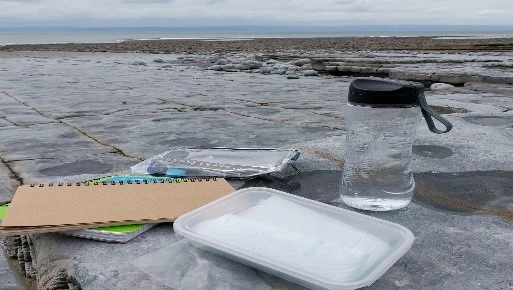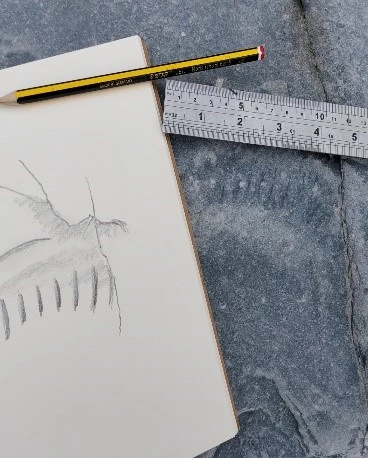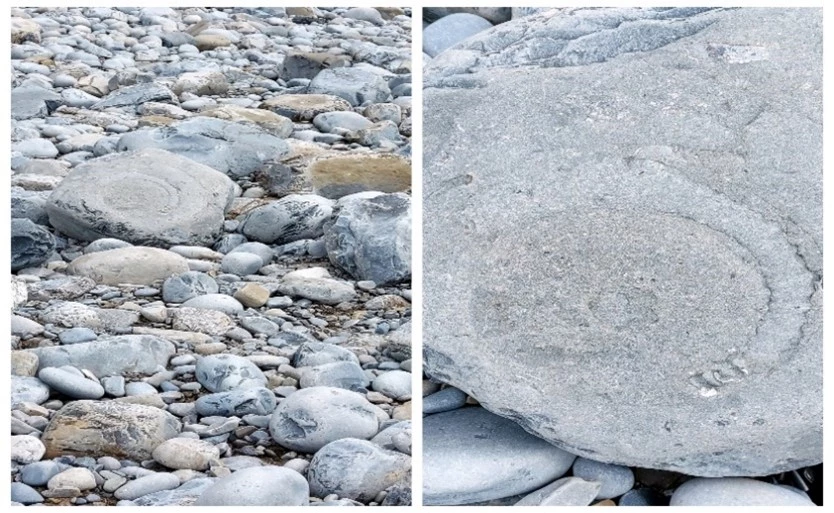Fossil Hunting at Llantwit Major
, 4 August 2021
Llantwit Major beach in the Vale of Glamorgan is a popular, rocky beach, backed with impressive cliffs. With views across the Bristol Channel towards Minehead on a clear day, it is a stunning and inspiring location. However, more importantly to you & me, Llantwit Major beach is one of the best places in Wales to find Jurassic fossils and is a treasure trove of undiscovered delights for fossil and nature explorers alike. So, on a cloudy afternoon, armed with my kit and sketchbook, I visited my favourite beach, to see what I could find…
The cliffs at Llantwit Major experience regular rockfalls which have sadly resulted in fatalities, so although it may be tempting to look for fossils within the recent rockfalls, it essential that all fossil hunters stay well away from the cliffs! As I walked towards the beach, this rockfall was out of sight, but within a few yards, there it was. A timely reminder to stay clear!
So, what did I take with me? Well you certainly don’t need a truck load of scientific equipment or a palaeontological assistant when fossil hunting! This is something that everyone can do with simple kit and a keen eye.
Before heading out hunting however, here are some things to consider:
- Check the tide times before you visit. It is safest to start your fossil hunting on a falling tide so that you don’t get cut off as the tide rises.
- Wear suitable footwear and clothing. Good, sturdy footwear is essential on this rocky terrain and be prepared for sudden changes in weather conditions.
- Fossil hunting can be thirsty work so it’s a good idea to bring some snacks and fluids to keep your energy levels up. The nearest café could be some distance away!
My kit
- Sturdy shoes.
- Drinking water.
- Kitchen roll to help carefully clean interesting finds.
- Things to document my experience, such as a sketchbook, a notepad, my phone (for the camera function), a ruler, pen and pencils.
I decided to walk to the left, at a safe distance from the cliff. The landscape here is varied and rocky, perfect for rock pools and fossil hunting.
I had a quick scan of the shale before looking at the boulders. The most common fossils found on this beach are likely to be molluscs such as ammonites and bivalves, although you might spot fish remains or even ichthyosaur bones if you’re lucky! You might also see beautiful examples of more modern shells. As I approached the larger boulders, I spotted some markings that looked like an ammonite, so I decided to investigate further.
I drew a simple sketch of my find and measured its size with my ruler. I also used my phone to take a photo of the locality with my finger pointing toward the fossil. This is a very simple way of documenting the location of interesting specimens so you can easily find them again if needed.
Eager to find more, I headed further down the beach. The boulders here become more fragmented and a particular one caught my eye. I’d found another ammonite impression! However, I decided not to risk hammering the rock around my find as this often damages fossils rather than removing them nicely. Imagine the feeling of accidentally destroying something that has been preserved for millions of years in a second with a wayward blow – it’s too much to bear! I decided to leave this fossil exactly where I found it. Llantwit Major is sadly becoming over collected, and I believe that this example should be left for others to enjoy. I hope you find it if you visit!
If you find any fossils or items of interest, please contact us at the museum via our website. We love seeing your discoveries and our team of experts will happily help you identify your finds and provide further information.
Remember - everybody can be a palaeontologist!
Happy hunting!
To find more resources to help you with your exploring why not check out
On Your Doorstep: Nature, geology and archaeology in Wales | National Museum Wales





Comments - (3)
Hi Terry
Just seen your question. Pumice in the strict sense is pale in colour not black; this is a product of the composition of the magma it forms from. As your specimen was black, then there are several possibilities (1) it may have been basalt scoria, different chemical composition to pumice but basically the same idea, frothed up lava as it is erupted; this would be rare in South Wales. If a correct identification, it would most likely be derived as ship ballast, but would have been deposited here sometime ago as rock has not been used as ballast for over 100 years. (2) if it was full of cavities like pumice, but wasn't low density (i.e. it wouldn't have floated in water) then it may be slag derived from the rich industrial past of South Wales with processing metal ores. (2) if it was quite low density, dark but not black when dry, and full of holes, it might be building material. Hope this helps; happy to look at a photo if you have one.
Jana
Head of Mineralogy & Petrology
Regards Terry